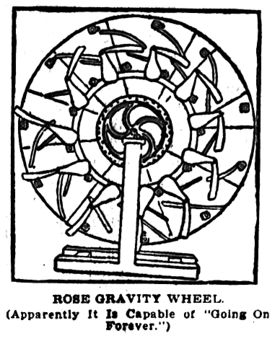Herbert Rose
From Kook Science
(Redirected from Rose Self-Acting Gravity Wheel Syndicate)
Herbert Rose (c. 1859 - ?) was an Australian geologist and inventor who devised a gravity wheel-type perpetual motion machine and spent several years soliciting funds for its development and sale, coming into some trouble with Australian authorities for his sale of shares in what he called the Rose Self-Acting Gravity Wheel Syndicate.

Patents
- Application No. 2984. — HERBERT ROSE, of 15 Surrey Road, Geologist, and WILLIAM HOCKING, of 20 Avoca Street, Gentleman, both of South Yarra, Victoria, "An improved Automatic or Self-acting Gravity Wheel." — Dated 5th June, 1900. (Refer Supplement to Government Gazette of Western Australia, 16 Nov. 1900, No. 66.)
Resources
Media Coverage
- "PERPETUAL MOTION. A MELBOURNE INVENTOR'S CLAIM. THE GREAT SECRET DISCOVERED.", The Age (Melbourne, Victoria, Aus.): 4, 20 Sept. 1900, https://www.newspapers.com/newspage/570896740/
- "NEW GRAVITY WHEEL. Its Inventor Thinks It Constitutes the Solution of the Secret of Perpetual Motion.", Hopkinsville Kentuckian (Hopkinsville, Ky.): 3, 15 Oct. 1901, https://chroniclingamerica.loc.gov/lccn/sn86069395/1901-10-15/ed-1/seq-3/
An improved automatic or self-acting gravity wheel is the modest title of an invention by Mr. Herbert Rose, of Australia, which has recently been patented all over the world, and which, if the claims of its inventor are realized, promises to supersede steam as motive power.
The invention relates to the construction of a gravity wheel, with concentric rings, secured to arms radiating from the center. These arms or weights act as balance and driving levers and are so nicely arranged — those on the downward grade being two-thirds heavier than those on the upward grade in action — that a natural falling of the weights on the former grade insures perpetual motion.
A cessation of the driving force can only he effected by preventing the weights from falling, and this is done by a very simple contrivance in the form of a spring which acts on all the weights simultaneously. Taking a wheel 40 feet in diameter and three feet wide, it is estimated that it will carry 1,050 weights and that the driving power will be equal to 1,443¾ tons from the center of the wheel. The cost of construction is about one- sixth the cost of machinery for steam power, and it is also claimed that the new motive power will reduce the working expenses 95 per cent.
The working model, says the New York Herald, has been subjected to continuous tests, as it is apparently capable, like the brook, of “going on forever,” which, of course, is what is expected of an invention claiming to constitute a solution of the secret of perpetual motion.
- "PERPETUAL MOTION - False Pretences Charge Preferred - ALLEGED FAKE INVENTION", Goulburn Evening Penny Post (Goulburn, NSW, Aus.): 2, 5 Dec. 1927, https://trove.nla.gov.au/newspaper/article/99315027
- "CHARGES OF FRAUD. Inventor Imprisoned. SECRET OF PERPETUAL MOTION.", Sydney Morning Herald (Sydney, NSW, Aus.): 11, 6 Dec. 1927, https://www.newspapers.com/newspage/124329758